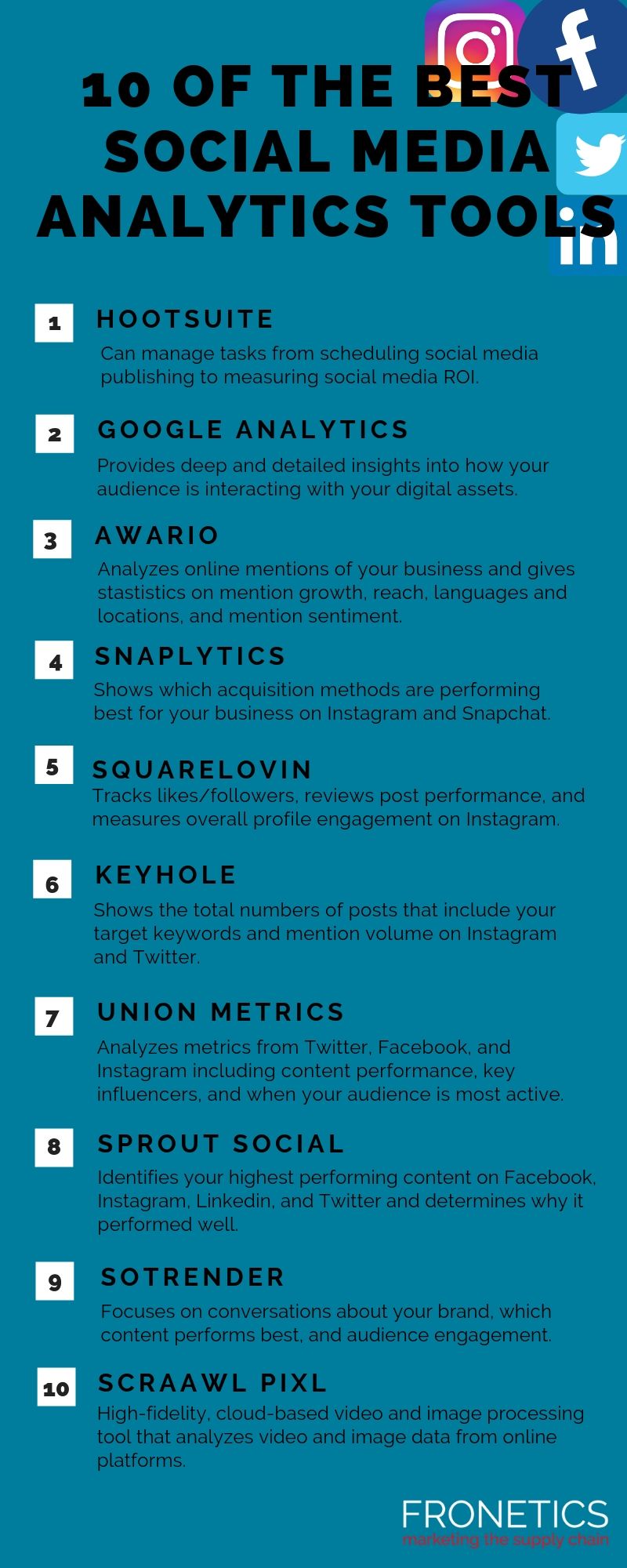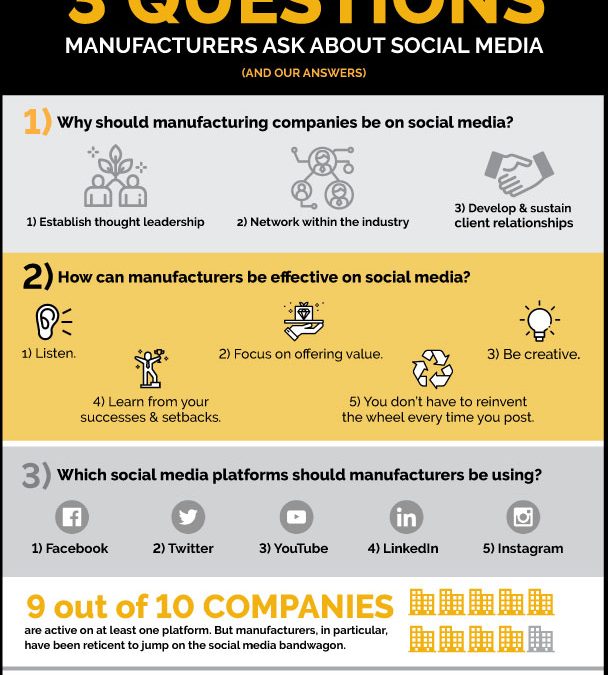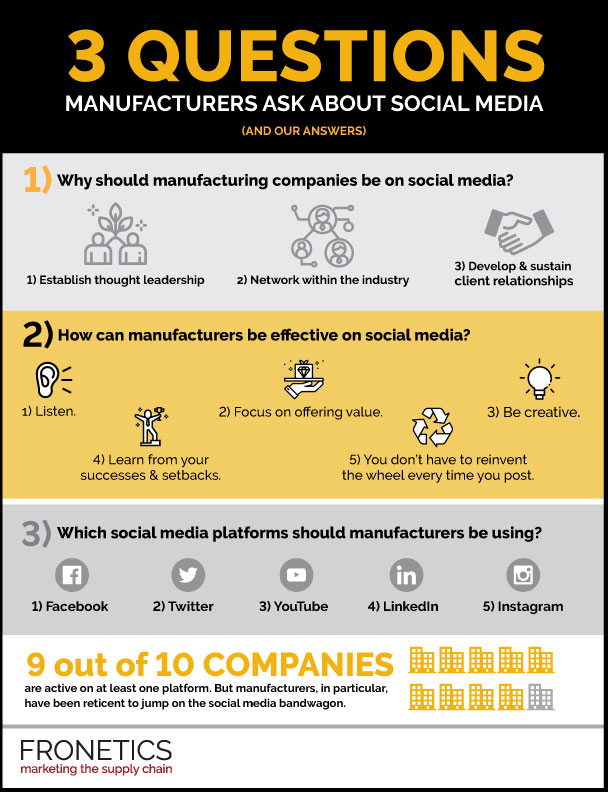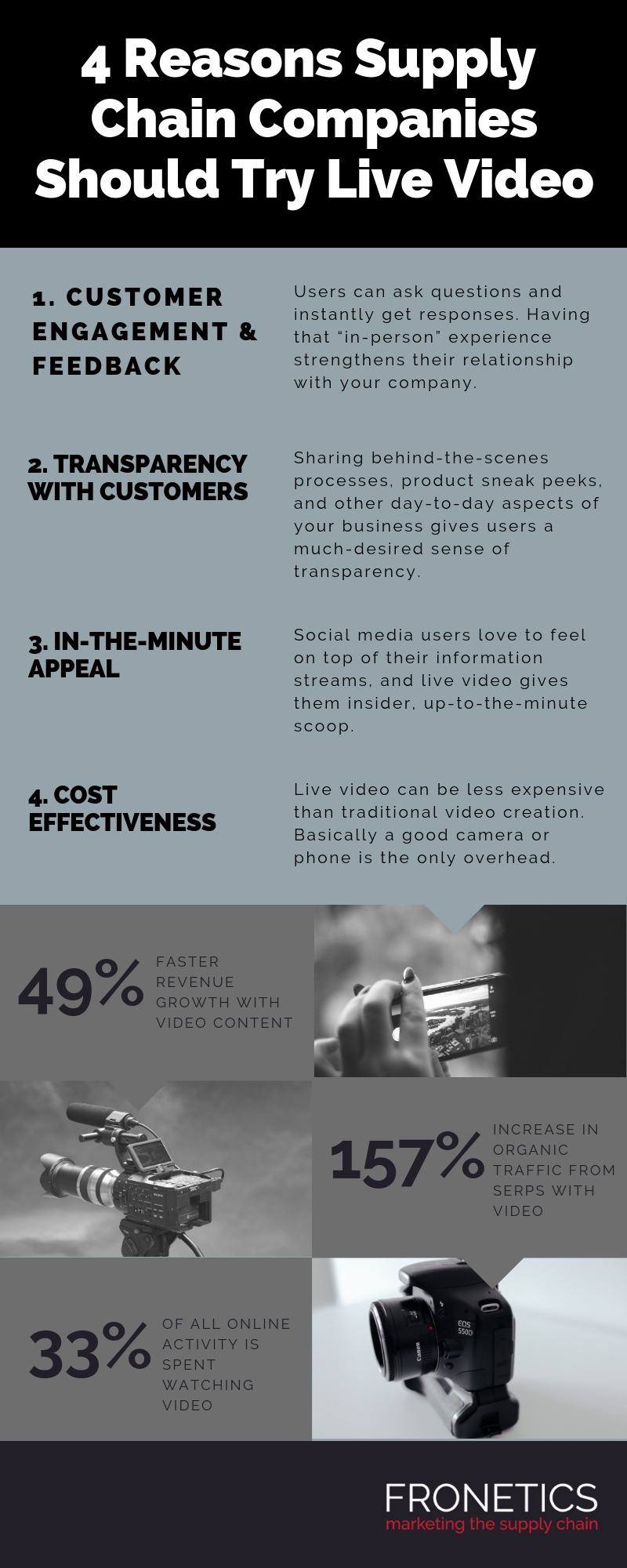
by Fronetics | Jul 18, 2019 | Blog, Logistics, Marketing, Social Media, Supply Chain
Reading social media blogs is an excellent way to ensure that your business is on top of the latest industry trends, insights, and analysis.
Highlights:
- Subscribe to blogs using an RSS reader to make sure you’re keeping up with the latest.
- Social Media Examiner is a great all-around source, while Social Media Today is the best place to go for up-to-the-minute news.
- Duct Tape Marketing is specifically geared to social media for small businesses.
It’s an old adage, but it holds true: When it comes to social media marketing, the only constant is change. Platforms are constantly refining their algorithms, seeking to stay in line with ever-evolving user behavior, and trends and memes come and go in the blink of an eye. In order to be successful, businesses need to stay abreast of all these constant shifts. Becoming a voracious reader of social media blogs is one of the best ways you can stay on top of what’s going on in the social media marketing world.
[bctt tweet=”Social media platforms are constantly refining their algorithms, seeking to stay in line with ever-evolving user behavior, and trends come and go in the blink of an eye.” username=”Fronetics”]
These five social media blogs are our favorite go-to resources for the latest news, as well as keen insights and expert analysis. Use your RSS reader to subscribe, and you’ll be privy to free knowledge from some of the leading industry voices.
Fronetics’ 5 favorite social media blogs in 2019
1) Social Media Examiner
Social Media Examiner has been one of our favorite social media blogs for years. Widely known for providing consistently valuable content, the blog features articles from in-house social media experts, as well as regular guest contributors.
We recommend Social Media Examiner whether you’re a beginner at social media marketing or a seasoned expert. The blog frequently features beginner-friendly, step-by-step guides to leveraging social media for marketing purposes, as well as up-to-date coverage of all the most important happenings in the industry, along with terrific analysis.
Recent must-read posts:
2) Duct Tape Marketing
If you’re a small business, Duct Tape Marketing is a fantastic resource for social media marketing specifically geared to small and midsized corporations. Social media is one of the blog’s main focus points, but it also offers suggestions and insights for digital marketing in a broader sense, SEO, marketing automation, and more — all of which help inform a robust social media strategy.
We love the strategies Duct Tape Marketing offers, with small businesses top of mind. You’ll find tactics for leveraging social media to generate leads, expand reach, and grow your business.
Recent must-read posts:
3) Social Media Today
When it comes to social media news, no one does it better than Social Media Today. The team of regular contributors posts several times a day and is remarkably adept at staying on the cutting edge of all the latest happenings, algorithms, and releases in the social media industry.
You won’t just find news on this social media blog. It’s also a rich resource for analysis, opinions, and insights, as well as tips and how-to articles from experienced marketers.
Recent must-read posts:
4) Socially Sorted
Run by social media guru Donna Mortiz, Socially Sorted has been named one of Social Media Examiner’s Top 10 Social Media Blogs for three years in a row. Mortiz personally authors most of the articles that appear on her blog and carefully curates contributors who bring expert perspectives to complement her own.
Socially Sorted focuses heavily on visual content social media platforms, like Instagram and Pinterest, but offers value for readers looking to round out their strategy on any platform. These days, visual content has a tremendous amount of power, and Mortiz is a fantastic resource for boosting your visual game.
Recent must-read posts:
5) Convince and Convert
No list of social media blogs is complete without Convince and Convert. While it’s a general digital and content marketing blog, it boasts a heavy focus on social media marketing topics. Founder Jay Baer and other industry experts offer a steady stream of new content, primarily in the form of how-to guides, case studies, tips, tools, and opinion pieces.
Convince and Convert is a good place for beginners and advanced social media marketers alike. However, more advanced readers will be better to take advantage of the specific and often highly technical guides. The topics never fail to be engaging and often slant toward using strategies informed by human psychology to optimize social influence.
Recent must-read posts:
Which social media blogs are you reading these days?
Related posts:


by Fronetics | Jun 11, 2019 | Blog, Content Marketing, Logistics, Marketing, Social Media, Supply Chain
An effective social media strategy requires data. Here are our 10 favorite social media analytics tools to empower you with insights that will boost your social media game.
Highlights:
- Hootsuite and Sprout Social are all-around social media management tools that offer analytics.
- Google Analytics is an overall powerhouse tool to track the performance of all your digital assets.
- Newcomers to the list include Awario, Squarelovin, Keyhole, and image analytics tool PixL.
At Fronetics, we believe in a data-driven approach to digital marketing. A solid analytical framework has the potential to offer insights that will shape and refine your strategies, increasing your ability to generate, nurture, and convert leads. We’ve pulled together 10 of the best social media analytics tools to help you determine what’s working and what’s not — and to empower you to develop a data-driven strategy.
Our 10 favorite social media analytics tools

(Made with Canva)
1) Hootsuite
There are so many tools out there, and our internal list of the best social media analytics tools often shifts. But there are a few platforms that always make the list, and Hootsuite is one of them. It’s one of the most popular social media management tools for a reason – it’s a powerhouse that can manage tasks from scheduling social media publishing to measuring social media ROI.
Hootsuite gives you key metrics from Twitter, Facebook, and Instagram with audience and post insights, as well as performance data. It packages all the data in approachable charts and graphs. One of our favorite features is the AutoSchedule tool, which lets Hootsuite determine the optimal time to post or tweet based on when similar content performed well in the past.
2) Google Analytics
Another of our perennial favorites, Google Analytics is a robust platform that can provide deep and detailed insights into how your audience is interacting with your digital assets, including social media. This is one of the best social media analytics tools out there, and we’ve written extensively about how to get the most out of it.
For social media analytics, we particularly recommend three custom reports: Best Days to Post on Social Media, Best Time to Post on Social Media, and the Social Media Traffic by Date and Hour. These three reports offer real-time data, along with the in-depth insight you need to help your business optimize its social media strategy.
3) Awario
Awario analyzes online mentions of your business and gives you statistics on mention growth, reach, mentions’ languages and locations, mention sentiment, and where on the web mentions are occurring. We particularly appreciate that the tool also identifies social media users who have used your keywords and provides you with a list of social media influencers in your specific area.
Benchmarking your social media marketing strategy against your competitors is key to understanding how you’re doing. Awario lets you create alerts for your main competitors and offers you a step-by-step comparison of your social media performance against theirs.
4) Snaplytics
While all-inclusive tools like Hootsuite and Google Analytics are excellent for evaluating your overall social media strategy, we also recommend a few tools that focus on specific platforms. Snaplytics hones in on Instagram and Snapchat, including offering insights on Instagram Stories.
For both networks, Snaplytics shows you which acquisition methods are performing best for your business, as well as what precipitates rises and falls in engagement levels. Snapchat can be a tricky platform for brands, and Snaplytics provides the kinds of insights you need to make inroads on this millennial-dominated network.
5) Squarelovin
We’ve written extensively about how supply chain companies can make the most of Instagram and Instagram Stories. Squarelovin is an analytics tool specifically for Instagram that provides you with the data you need to optimize your strategy. It tracks likes and followers, reviews post performance, and measures overall profile engagement.
One of the best social media analytics tools for Instagram out there, Squarelovin highlights the best times to post, ideal filters to use, and most popular hashtags. It also gives you a history of engagement with your posts, broken down by hour.
6) Keyhole
This social media monitoring tool offers up deep analytics for Twitter and Instagram. Keyhole will show you the total number of posts that include your target keywords, as well as how mention volume has changed over time. It displays engagement data, hashtag usage trends, sentiment metrics, and reach statistics.
Influencers are key on Instagram and Twitter, and influencer marketing should be part of your social media strategy. Keyhole provides insights into influencers and trends in your specific niche, along with audience demographics and locations.
7) Union Metrics
Union Metrics analyzes a range of metrics from Twitter, Facebook, and Instagram. Like Hootsuite, it lets you know which content is performing best across each platform, the times when your audience is most active throughout the day, and who your key influencers are.
What really sets Union Metrics apart is in its potential for optimizing content creation. The tool goes above and beyond by tracking relevant trends to help you generate ideas for new content, based on hard performance data.
8) Sprout Social
Sprout Social is probably Hootsuite’s biggest competitor, and it’s another of our frequent favorites. Like Hootsuite, it’s an all-around social media management tool that provides key analytics as well. It measures performance and engagement across Facebook, Instagram, LinkedIn, and Twitter and benchmarks your data against competitors.
Sprout Social also helps you identify your highest performing content and determine why it has performed well. It can also show you how your paid ads are performing through a comparison of paid versus organic impressions and followers gained.
9) Sotrender
This formidable social media analytics tool shows you where conversations about your brand are happening, which of your content performs best, and how your audience engages with your social media content. Sotrender analyzes Twitter, YouTube, Facebook, and Instagram and makes it easy for you to benchmark your efforts against your competitors.
We like any tool that not only offers data but gives you advice for improving your strategy. Sotrender offers customized tips on where your marketing strategy needs improvement, based on the analysis it performs.
10) Scraawl PixL
As the internet, and social media in particular, becomes more visual, experts have pointed to a dearth of analytics tools with the capability to perform rich analysis on images. Scraawl PixL is a relatively new kid on the block, and it’s attempting to fill the void when it comes to image-based analytics.
This high-fidelity, cloud-based video and image processing exploitation tool offers an easy-to-use interface, as well as workflows for analyzing video and image data from online digital platforms. It relies on machine learning-based algorithms that enable face detection and recognition as well as object detection, tracking, and classification.
What are your favorite social media analytics tools?
Related Posts:


by Fronetics | May 1, 2019 | Blog, Content Marketing, Logistics, Manufacturing & Distribution, Marketing, Social Media, Supply Chain
We get many queries from manufacturers about social marketing — mostly, why and how should I use it — so here are our answers to the most-popular questions manufacturers ask about social media.
Highlights:
- Facilitate networking opportunities, thought leadership, and prospect/client relationships.
- Consider using popular platforms like YouTube and Instagram to engage users and drive website traffic.
- Don’t use social media to push your products.

(Made with Canva)
B2B operations have increasingly embraced social media as a strategic marketing tool. In fact, 9 out of 10 companies are active on at least one platform. But manufacturers, in particular, have been reticent to jump on the social media bandwagon.
If your manufacturing operation isn’t making use of social media as a tool to engage with your audience, you’re missing out on big lead generation potential. Manufacturers like the Dow Chemical Company, ArcelorMittal, and CAT Products are among those that have figured out how to harness the power of social media.
To help you launch or refine your efforts, we’ve put together the following answers to the most-popular questions manufacturers ask about social media.
Why should manufacturing companies be on social media?
There are three major reasons that manufacturing brands should be all over social media:
- Establish thought leadership
- Network within the industry
- Develop and sustain client relationships
Notice that none of these involve selling products. As with content marketing in general, good social media marketing isn’t about pushing your products.
[bctt tweet=”The value of social media for manufacturers is in its potential to establish and expand thought leadership and to cultivate meaningful and fruitful relationships within your industry and among prospects and clients.” username=”Fronetics”]
To make the most of social media as a marketing tool, abandon the idea that it’s about blatant sales pitches. Instead, approach it from the perspective that it’s an inherently social tool – that is, its value for manufacturers is in its potential to establish and expand thought leadership and to cultivate meaningful and fruitful relationships within your industry and among prospects and clients.
Which social media platforms should manufacturers be using?
Not all social media platforms are created equal. Each requires its own strategy, content format, and media. We recommend that manufacturers consider these five platforms:
1) Facebook
Facebook is an excellent place to share content with a wide segment of your audience, to promote engagement (through likes, comments, and shares), and to engage with peers and prospects. Not only that, the savviest marketers are using Facebook to understand their industry better – everything from strategies of peer brands to a fuller picture of your target buyer persona to the informational or product needs of your prospects.
2) Twitter
Twitter’s format is about brief, pithy content, used to engage with and inform your audience. This is an ideal place to let customers know what you’re planning next, to establish your corporate personality, and to let your audience in on a slice of your day-to-day operations and values.
3) YouTube
Video marketing for manufacturers is skyrocketing. With video being the most popular form of content online today, YouTube is an obvious choice for marketers. Whether it’s “how to” videos, footage of your operations, or interviews with subject-matter experts, your brand should be using YouTube to drive search traffic and educate prospects.
4) LinkedIn
B2B marketers unequivocally rank LinkedIn as the most effective network for lead generation, follower engagement, and traffic to their websites. An ideal place to engage with industry leaders, LinkedIn is also great for distributing content to a focused audience.
5) Instagram
The popularity of this highly visual platform has continued to skyrocket – it’s currently the second-most-used social media platform (up from fourth just two years ago). And believe it or not, this picture-based network is a powerhouse for B2B brands. We’ve written extensively about how brands can leverage Instagram and Instagram Stories. Suffice it to say, this is a perfect place to post your most engaging visual content and actively engage with followers.
How can manufacturers be effective on social media?
As with any content marketing effort, a well-thought-out social media strategy is a big part of success. As you create and begin to implement your strategy, start with these five tips.
1) Listen.
Before you post even a single piece of content, start by listening to your audience. In the days before social media, marketers had it much harder when it came to determining audience needs and preferences. Use these platforms to research your target prospects, as well as how competitors are engaging followers. Make note of the questions your target audience has, frustrations or challenges they express, and what types of content they engage with.
2) Focus on offering value.
You’d be surprised how many manufacturers neglect to place a premium on simply being useful with their social media content. It’s not complicated: If you post relevant, valuable content for your target audience, you’ll boost engagement, grow brand awareness, and generate and convert more leads.
3) You don’t have to reinvent the wheel every time you post.
One of the great things about social media is that it rewards not only content creation, but content curation. While you do want to be posting original content most of the time (experts recommend about 60%), a good chunk of your posting activity should include curating relevant content from third parties to share with your followers.
4) Be creative.
Separating yourself from your competitors can be a challenge, but it’s one worth striving toward. Start by asking yourself what makes your operation unique, what’s special about your process, what industry-leading expertise does your executive team have, what unusual perspective can you offer? Next, start breaking these four rules.
5) Learn from your successes and setbacks.
There are many tools out there to help you track the results of your social media efforts. Determine the right KPIs for your business and keep track of your results relentlessly. These metrics will allow you to study your impact and frequently tailor your strategy accordingly.
It’s time for manufacturers to fully embrace the marketing potential of social media. Whether you create and implement your own strategy, or decide to outsource your social media efforts, social media is a powerful set of tools that manufacturers should be harnessing.
Are there other questions manufactures ask about social media that we missed? Let me know in the comments.
Related posts:


by Fronetics | Jan 3, 2019 | Blog, Content Marketing, Logistics, Marketing, Social Media, Supply Chain
Live video streaming helps businesses promote transparency, good communication, and relatability.
Live video is one the biggest trends in social media marketing right now. According to the 2018 Social Media Marketing Industry Report, 77 percent of marketers plan to increase their use of video this year and 68 percent want to start using live video.
[bctt tweet=”77 percent of marketers plan to increase their use of video this year and 68 percent want to start using live video.” username=”Fronetics”]
It’s really no surprise video has gained such traction. Platforms like YouTube made the transition from watching TV in your home to watching videos on your phone seamless. And live streaming fits in with today’s emphasis on corporate transparency and putting a real, human face to business social media accounts. It allows brands to drop their corporate façade and connect to users in a more human way.
Before you ask, let me say it again: Yes, video can work for the supply chain.
Starbucks and live streaming
You don’t have to take our word for it. Look at the success of Starbucks. Back in 2016 the coffee giant tried their first live feed at an event in Queens, New York, to promote National Voter Registration Day. The live video showcased Starbuck’s involvement in the community and their dedication to social events. It was a huge success. The streaming content allowed viewers who wouldn’t otherwise be able to make the event learn about the cause and its importance.
Still not convinced? Check out this infographic with 4 reasons why the supply chain needs to try live video.
Infographic: 4 reasons the supply chain needs live video

(Made with Canva)
Live streaming platforms
Want to dive into live video, but don’t know where to start? Here’s a few of the most popular platforms.
- Facebook Live: Facebook Live lets you broadcast in real time for up to 90 minutes per session. Users who have recently engaged (or who frequently engage) with your page will receive a notification that you are streaming live, and they can go to your page to view the video. Viewers can comment and react during the course of your broadcast, allowing you to read their remarks and respond immediately.
- Periscope: Twitter-owned and run, Periscope is a standalone platform but integrates seamlessly with Twitter. It has more than 10 million users, more than two million of whom log in daily. The service lets users live stream from their mobile devices and push out those streams on Twitter.
- YouTube Live: YouTube Live enables YouTube to utilize its expansive creator and advertising network to generate even more video to be hosted and monetized. YouTube makes it incredibly easy to aim, shoot and post live video.
Related posts:


by Fronetics | Apr 12, 2018 | Blog, Content Marketing, Leadership, Marketing, Social Media, Supply Chain
Make the most of your supply chain leaders’ social media accounts by following these steps.
I’ve written many times before about the importance of supply chain leaders being on social media as the face of their brands. Social media presents a huge opportunity for executives to use their relative industry celebrity to be an extension of their organizations.
So you are ready to commit to a more active social media presence (or you’re going to be ghost-posting for your executive). Where do you begin?
We’ve come up with 4 tips for supply chain leaders to making the most of their presence on social media.
4 tips for supply chain leaders on social media
1) Find the right platform (or platforms) for you.
The first thing to consider is your target audience. If you’re looking to reach a young demographic, for example, Snapchat is probably the way to go, as 45% of its users are under the age of 24. Likewise, if your brand would be well-served by live video (hint: it probably will!), Facebook Live and Instagram Stories offer great possibilities.
Next, think about your personal voice, and what type of content you are likely to be posting. Thought leadership can often best be established on LinkedIn. But that doesn’t mean that Facebook, Twitter, and YouTube aren’t also good avenues to present your voice to the world. Pick the platforms that you feel speak most to your audience and best serve your brand.
2) Use your creative side.
Supply chain and logistics leadership requires a tremendous amount of creativity and innovation. Let these qualities shine through in your social media presence! You have the tools to spark more engagement, increase follower count, and make your posts go viral.
This means using your unique voice to be a storyteller, engage your audience, and create a face for your brand. If you need some inspiration, check out these 7 Twitter accounts.
3) Create space for conversation.
Too many would-be social media mavens fall into the trap of posting the kind of content that doesn’t invite interaction. Instead, be a conversation-starter.
First, take a look at your audience and what kind of interactions they have online. You can scan the pages of other leaders in your niche as a reference point.
You can generate interaction and engagement by showing gratitude, listening to your audience, handling queries, posting thought-provoking content, and posing questions in your posts.
4) Avoid controversy.
This might seem obvious, but there’s a fine line to walk between posting or re-posting thought-provoking content and becoming an inadvertently controversial figure.
Keep in mind that, in the public platforms that are social media, all your moves will be under constant scrutiny from your fans, followers, and people in their networks. This means that while cultivating a personal voice, it’s important to maintain a level of professionalism. And stay away from posting anything that can make you a lightning rod for controversy!
Where do you go to follow supply chain leaders on social media?
Related posts:












